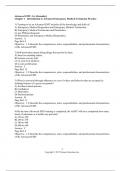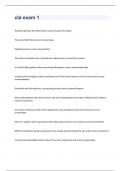Advanced EMT, 2e (Alexander)
Chapter 1 Introduction to Advanced Emergency Medical Technician Practice
1) Training to be an Advanced EMT includes all the knowledge and skills of:
A) Emergency Medical Responders and Emergency Medical Technicians.
B) Emergency Medical Technicians and Paramedics.
C) any EMS professional.
D) Paramedics and Emergency Medical Responders.
Answer: A
Page Ref: 8
Objective: 1.2 Describe the competencies, roles, responsibilities, and professional characteristics
of the Advanced EMT.
M
2) Self-motivation means doing things that need to be done:
ED
A) based on standing orders.
B) because you are told.
C) on your own initiative.
D) to earn certification.
C
Answer: C
Page Ref: 12
O
Objective: 1.2 Describe the competencies, roles, responsibilities, and professional characteristics
of the Advanced EMT.
N
3) What is conveyed through adherence to a set of values and behavior that are accepted as
N
defining features of a given occupation?
A) Evidence-based practice
O
B) Confidence
C) Motivation
IS
D) Professionalism
Answer: D
SE
Page Ref: 11
Objective: 1.2 Describe the competencies, roles, responsibilities, and professional characteristics
of the Advanced EMT.
U
4) By the time Advanced EMT training is completed, the AEMT will have completed how many
R
hours of education as a health care provider?
A) 150 to 250
B) 240 to 350
C) 300 to 440
D) 400 to 640
Answer: C
Page Ref: 8
Objective: 1.2 Describe the competencies, roles, responsibilities, and professional characteristics
of the Advanced EMT.
1
Copyright © 2017 Pearson Education, Inc.
,5) Which of the following statements is CORRECT?
A) An EMR license is a prerequisite for EMT.
B) EMT training is a prerequisite for Advanced EMT.
C) AEMTs provide complex patient assessments.
D) The AEMT core program includes 1000 hours of education.
Answer: B
Page Ref: 8
Objective: 1.2 Describe the competencies, roles, responsibilities, and professional characteristics
of the Advanced EMT.
6) Before you can render care to a patient, you MUST:
A) ensure your emergency vehicle is in good working order.
M
B) compile a list of the patient's medications.
C) call medical direction for orders.
ED
D) wait to have a paramedic on scene.
Answer: A
Page Ref: 8-9
Objective: 1.4 Place the roles and responsibilities of the Advanced EMT in the larger contexts of
C
emergency medical services (EMS), health care, and public health.
O
7) All of the following are important to providing medical care safely, EXCEPT:
A) using appropriate personal protective equipment.
N
B) double checking medication doses.
C) driving with "due regard."
N
D) wearing a N-95 respirator during extrication.
Answer: D
O
Page Ref: 9
Objective: 1.5 Discuss key issues in the contemporary practice of the Advanced EMT, including
IS
professionalism, the focus on patient safety, research, and evidence-based practice.
SE
8) Who is responsible for on-scene safety of EMS providers?
A) Traffic director
B) Law enforcement
U
C) All crew members
D) Triage officer
R
Answer: C
Page Ref: 9
Objective: 1.5 Discuss key issues in the contemporary practice of the Advanced EMT, including
professionalism, the focus on patient safety, research, and evidence-based practice.
2
Copyright © 2017 Pearson Education, Inc.
,9) Which of the following is TRUE regarding "evidenced based practice"?
A) It does not require significant prehospital research.
B) It may challenge previously unquestioned practices.
C) It only evaluates evidence of validity.
D) It relies on traditional treatment techniques.
Answer: B
Page Ref: 10
Objective: 1.5 Discuss key issues in the contemporary practice of the Advanced EMT, including
professionalism, the focus on patient safety, research, and evidence-based practice.
10) Maintaining AEMT certification or the license to practice as an AEMT is the responsibility
of the:
M
A) system's medical director.
B) system's training officer.
C) AEMT.
ED
D) shift supervisor.
Answer: C
Page Ref: 11
C
Objective: 1.2 Describe the competencies, roles, responsibilities, and professional characteristics
of the Advanced EMT.
O
11) To maintain your license or certification, all of the following are required EXCEPT:
N
A) documentation of mandatory continuing education activities.
B) submission of a CPR card.
N
C) payment of fees for renewal.
D) evidence of a negative TB skin test.
O
Answer: D
Page Ref: 11
IS
Objective: 1.2 Describe the competencies, roles, responsibilities, and professional characteristics
of the Advanced EMT.
SE
12) When interacting with other health care providers, it is important that you:
A) tell them that you know what you are doing.
U
B) communicate respectfully.
C) critique their patient care skills.
R
D) demonstrate that you are in charge.
Answer: B
Page Ref: 13
Objective: 1.5 Discuss key issues in the contemporary practice of the Advanced EMT, including
professionalism, the focus on patient safety, research, and evidence-based practice.
3
Copyright © 2017 Pearson Education, Inc.
, 13) Which of the following demonstrates "integrity"?
A) Being thorough, accurate, and honest on your daily vehicle and equipment checklists
B) Showing compassion and understanding for others
C) Changing out the oxygen cylinder when it gets low without being asked
D) Keeping your fingernails clean and trimmed
Answer: A
Page Ref: 12
Objective: 1.2 Describe the competencies, roles, responsibilities, and professional characteristics
of the Advanced EMT.
14) Looking at something from the patient's point of view is an example of:
A) self-motivation.
M
B) empathy.
C) integrity.
ED
D) sympathy.
Answer: B
Page Ref: 12
Objective: 1.2 Describe the competencies, roles, responsibilities, and professional characteristics
C
of the Advanced EMT.
O
15) Cleaning the surfaces of the patient care compartment without being asked is an example of:
A) self-motivation.
N
B) empathy.
C) integrity.
N
D) professionalism.
Answer: A
O
Page Ref: 12
Objective: 1.2 Describe the competencies, roles, responsibilities, and professional characteristics
IS
of the Advanced EMT.
SE
16) One of the leading factors in making mistakes is:
A) putting your patient's welfare first.
B) observing the "golden rule."
U
C) reading too many EMS journals.
D) being overconfident about your skills.
R
Answer: D
Page Ref: 12
Objective: 1.4 Place the roles and responsibilities of the Advanced EMT in the larger contexts of
emergency medical services (EMS), health care, and public health.
4
Copyright © 2017 Pearson Education, Inc.





